15 sept 2018
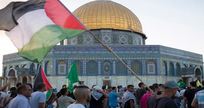
By Rebecca Stead
What: After a group of extremist Israelis stormed Al-Aqsa Mosque, waves of violence broke out across Jerusalem, the West Bank and Gaza.
Where: Jerusalem
When: 14 September 2015
What happened?
On 13 September 2015, the eve of Rosh Hashanah (Jewish New Year), a number of Jewish Israelis visited the Al-Aqsa Mosque compound. The Israeli Minister of Agriculture, Uri Ariel, entered Al-Haram Al-Sharif escorted by heavily armed Israeli soldiers. Palestinians gathered in the compound to protest the visits, since Israelis are prohibited from praying on the site under the status quo agreement. Israeli forces dispersed the protesters with violence, using tear gas and rubber bullets.
That evening an Israeli man was killed in East Talpiot, a neighbourhood in southern Jerusalem, after he lost control of his car when stones were reportedly thrown by Palestinians. Israeli Prime Minister Benjamin Netanyahu subsequently announced that he would meet with key ministers to “discuss deterrent measures against Palestinian rock-throwers,” the Times of Israel reported.
The following day, on 14 September, more extremist Israelis broke into the Al-Aqsa Mosque compound via the Mughrabi gate. Jordan’s King Abdullah issued a warning to Israel in a rare move, warning that continued fighting could weaken relations between the two states. On 15 September a day of rage was declared in Gaza and the occupied West Bank. Palestinian citizens of Israel also took to the streets in a general strike, closing businesses and schools while tens of thousands gathered for a peaceful rally in Sakhnin, north of Nazareth, chanting slogans against the Israeli government.
Tensions were compounded by the events of the summer which saw the murder of the Dawabsheh family in Duma, in the occupied West Bank. The family, including their 18-month-old son Ali, were the victims of an arson attack by extremist Jewish settler Amiram Ben-Uliel. Only Ahmed, then five years old, survived the attack. A student at Palestine’s Birzeit university, Ehab Iwidat, who took part in protests that spread across the occupied West Bank in the autumn, told Al Jazeera that the violence resulted “from the actions of settlers, who represent Israeli government policy. From burning people alive, humiliating people on a daily basis and restricting Palestinians’ freedom movement, to the disrespectful actions at Al-Aqsa Mosque”.
International media quickly began to label the upsurge in violence “a third intifada,” or uprising. The Guardian reported that “there is concern among diplomats and analysts in the region that the escalating violence could turn into a new intifada”. Foreign Policy added that: “Once again, politicians and pundits debate what to call it. On this matter, there is rare agreement between Ismail Haniyeh, the Gaza-based leader of Hamas, and Isaac Herzog, the Israeli opposition leader: Both say that we are witnessing the beginning of the Third Intifada.”
The unrest escalated further after an Israeli settler couple were killed on 1 October while driving on highway 60 near Nablus. The couple lived in the illegal settlement of Neria, west of Ramallah, and one was a US citizen. The Israeli military launched a manhunt for the perpetrators, undertaking incursions into West Bank towns and villages, night raids and widespread arrests which sparked anger among Palestinians.
International observers condemned Israel’s heavy-handed response to the events of Autumn 2015. In October, Amnesty International issued a report stating there were “at least four incidents in which Palestinians were deliberately shot dead by Israeli forces when they posed no imminent threat to life, in what appear to have been extrajudicial executions”. One such incident was the shooting of 19-year-old Sa’ad Muhammad Youssef Al-Atrash in the Old City of Hebron by Israeli forces as he attempted to retrieve an ID card at an Israeli soldier’s request.
What happened next?
According to the UN’s OCHAoPt, “2015 recorded the highest number of casualties among West Bank Palestinians since 2005, when OCHA began documenting incidents”. Hundreds of Palestinians died from tear gas inhalation, rubber bullets and from live ammunition shot by Israeli forces. Thirty children were killed by Israeli forces and settlers, the highest number recorded since 2006.
Some commentators believe that this “third intifada” never really ended. In March 2016, Israeli solider Elor Azaria was caught on camera shooting 21-year-old Palestinian Abdel Fattah Al-Sharif in the head while he lay wounded on the ground in Hebron, in the south of the occupied West Bank. Azaria was convicted of manslaughter but only served a fraction of his sentence. In 2018 Azaria boasted that he “had no remorse whatsoever” for killing Al-Sharif and would do the same again if the situation were repeated.
By mid-June 2016, incidents were still ongoing, including the killing of four Israelis in Tel Aviv’s Sarona market and the killing of a 13-year-old girl as she slept in the illegal settlement of Kiryat Arba near Hebron. In response, Israel demolished a Palestinian home in Bani Naim, east of the city. It is estimated that since the wave of violence began on 14 September 2015, 260 Palestinians were killed, 191 of which were men and 12 of which were women. Of these 260, 57 were minors.
Tensions have continued to flare sporadically since then, with July 2017 seeing widespread protests in response to Israel’s installation of metal detectors at the entrance to Jerusalem’s Al-Aqsa Mosque. Israel closed the mosque and stopped Friday prayers from being held there for the first time in 17 years after three Palestinians and two Israelis were killed. More than 450 Palestinians were injured in the following days, while tensions spilled over into Jordan when a 16-year-old Jordanian was killed by an Israeli embassy security guard on 23 July.
In December 2017, US President Donald Trump’s decision to move the US embassy to Jerusalem and unilaterally recognize the city as Israel’s capital once again sparked unrest. The Great March of Return which followed in spring 2018 has seen around 170 Palestinians killed.
- Rebecca Stead is an MA student at SOAS University of London studying Middle Eastern Studies with Arabic, Stead focuses on the history, culture and politics of Israel-Palestine specifically and the Levant more broadly. She has traveled in the region and studied Arabic in Jerusalem and Amman, and works in a freelance capacity for a number of journals and blogging platforms. Her article appeared in MEMO.
What: After a group of extremist Israelis stormed Al-Aqsa Mosque, waves of violence broke out across Jerusalem, the West Bank and Gaza.
Where: Jerusalem
When: 14 September 2015
What happened?
On 13 September 2015, the eve of Rosh Hashanah (Jewish New Year), a number of Jewish Israelis visited the Al-Aqsa Mosque compound. The Israeli Minister of Agriculture, Uri Ariel, entered Al-Haram Al-Sharif escorted by heavily armed Israeli soldiers. Palestinians gathered in the compound to protest the visits, since Israelis are prohibited from praying on the site under the status quo agreement. Israeli forces dispersed the protesters with violence, using tear gas and rubber bullets.
That evening an Israeli man was killed in East Talpiot, a neighbourhood in southern Jerusalem, after he lost control of his car when stones were reportedly thrown by Palestinians. Israeli Prime Minister Benjamin Netanyahu subsequently announced that he would meet with key ministers to “discuss deterrent measures against Palestinian rock-throwers,” the Times of Israel reported.
The following day, on 14 September, more extremist Israelis broke into the Al-Aqsa Mosque compound via the Mughrabi gate. Jordan’s King Abdullah issued a warning to Israel in a rare move, warning that continued fighting could weaken relations between the two states. On 15 September a day of rage was declared in Gaza and the occupied West Bank. Palestinian citizens of Israel also took to the streets in a general strike, closing businesses and schools while tens of thousands gathered for a peaceful rally in Sakhnin, north of Nazareth, chanting slogans against the Israeli government.
Tensions were compounded by the events of the summer which saw the murder of the Dawabsheh family in Duma, in the occupied West Bank. The family, including their 18-month-old son Ali, were the victims of an arson attack by extremist Jewish settler Amiram Ben-Uliel. Only Ahmed, then five years old, survived the attack. A student at Palestine’s Birzeit university, Ehab Iwidat, who took part in protests that spread across the occupied West Bank in the autumn, told Al Jazeera that the violence resulted “from the actions of settlers, who represent Israeli government policy. From burning people alive, humiliating people on a daily basis and restricting Palestinians’ freedom movement, to the disrespectful actions at Al-Aqsa Mosque”.
International media quickly began to label the upsurge in violence “a third intifada,” or uprising. The Guardian reported that “there is concern among diplomats and analysts in the region that the escalating violence could turn into a new intifada”. Foreign Policy added that: “Once again, politicians and pundits debate what to call it. On this matter, there is rare agreement between Ismail Haniyeh, the Gaza-based leader of Hamas, and Isaac Herzog, the Israeli opposition leader: Both say that we are witnessing the beginning of the Third Intifada.”
The unrest escalated further after an Israeli settler couple were killed on 1 October while driving on highway 60 near Nablus. The couple lived in the illegal settlement of Neria, west of Ramallah, and one was a US citizen. The Israeli military launched a manhunt for the perpetrators, undertaking incursions into West Bank towns and villages, night raids and widespread arrests which sparked anger among Palestinians.
International observers condemned Israel’s heavy-handed response to the events of Autumn 2015. In October, Amnesty International issued a report stating there were “at least four incidents in which Palestinians were deliberately shot dead by Israeli forces when they posed no imminent threat to life, in what appear to have been extrajudicial executions”. One such incident was the shooting of 19-year-old Sa’ad Muhammad Youssef Al-Atrash in the Old City of Hebron by Israeli forces as he attempted to retrieve an ID card at an Israeli soldier’s request.
What happened next?
According to the UN’s OCHAoPt, “2015 recorded the highest number of casualties among West Bank Palestinians since 2005, when OCHA began documenting incidents”. Hundreds of Palestinians died from tear gas inhalation, rubber bullets and from live ammunition shot by Israeli forces. Thirty children were killed by Israeli forces and settlers, the highest number recorded since 2006.
Some commentators believe that this “third intifada” never really ended. In March 2016, Israeli solider Elor Azaria was caught on camera shooting 21-year-old Palestinian Abdel Fattah Al-Sharif in the head while he lay wounded on the ground in Hebron, in the south of the occupied West Bank. Azaria was convicted of manslaughter but only served a fraction of his sentence. In 2018 Azaria boasted that he “had no remorse whatsoever” for killing Al-Sharif and would do the same again if the situation were repeated.
By mid-June 2016, incidents were still ongoing, including the killing of four Israelis in Tel Aviv’s Sarona market and the killing of a 13-year-old girl as she slept in the illegal settlement of Kiryat Arba near Hebron. In response, Israel demolished a Palestinian home in Bani Naim, east of the city. It is estimated that since the wave of violence began on 14 September 2015, 260 Palestinians were killed, 191 of which were men and 12 of which were women. Of these 260, 57 were minors.
Tensions have continued to flare sporadically since then, with July 2017 seeing widespread protests in response to Israel’s installation of metal detectors at the entrance to Jerusalem’s Al-Aqsa Mosque. Israel closed the mosque and stopped Friday prayers from being held there for the first time in 17 years after three Palestinians and two Israelis were killed. More than 450 Palestinians were injured in the following days, while tensions spilled over into Jordan when a 16-year-old Jordanian was killed by an Israeli embassy security guard on 23 July.
In December 2017, US President Donald Trump’s decision to move the US embassy to Jerusalem and unilaterally recognize the city as Israel’s capital once again sparked unrest. The Great March of Return which followed in spring 2018 has seen around 170 Palestinians killed.
- Rebecca Stead is an MA student at SOAS University of London studying Middle Eastern Studies with Arabic, Stead focuses on the history, culture and politics of Israel-Palestine specifically and the Levant more broadly. She has traveled in the region and studied Arabic in Jerusalem and Amman, and works in a freelance capacity for a number of journals and blogging platforms. Her article appeared in MEMO.
2 june 2018
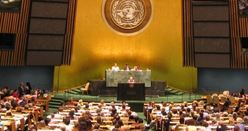
The Kuwaiti ambassador to the United Nations Mansour Al-Otaibi vowed to go to the General Assembly for the protection of Palestinians after a draft resolution of his delegation for that purpose was vetoed by the United States.
Earlier Friday, the UNSC voted on a Kuwait-drafted resolution calling for setting up an international protection for the Palestinian people following the killing of dozens of peaceful Palestinian protestors by Israeli forces in Gaza.
Out of the council's 15 members, 10 voted in favor, including France, and only the US voted against. There were four abstentions including Britain.
"We will consider going to the General Assembly, going to other UN bodies to try to find a way to provide international protection for the Palestinian civilians," Al-Otaibi told reporters..
Al-Otaibi said he was disappointed by the U.S. veto of his delegation's draft resolution.
Ten of the 15 members of the Security Council voted in favor of the Kuwaiti draft, and only the United States voted against it, he noted.
Earlier Friday, the UNSC voted on a Kuwait-drafted resolution calling for setting up an international protection for the Palestinian people following the killing of dozens of peaceful Palestinian protestors by Israeli forces in Gaza.
Out of the council's 15 members, 10 voted in favor, including France, and only the US voted against. There were four abstentions including Britain.
"We will consider going to the General Assembly, going to other UN bodies to try to find a way to provide international protection for the Palestinian civilians," Al-Otaibi told reporters..
Al-Otaibi said he was disappointed by the U.S. veto of his delegation's draft resolution.
Ten of the 15 members of the Security Council voted in favor of the Kuwaiti draft, and only the United States voted against it, he noted.

The United States has used its veto power, Friday, against a draft resolution at the United Nations, calling for providing protection to the Palestinian People, living under illegal Israeli occupation.
The Veto came after the resolution was backed by 10 counties at the UN Security Council.
The resolution was sponsored by Kuwait; it requires nine votes to be adopted by the 15-member council, and was voted for by ten countries, including Russia, China and France.
Four counties, including Britain, abstained while the United States, the only country that opposed it, used its Veto power to topple the resolution.
The draft resolution denounced the Israeli military escalation against the Palestinian people, and the use of “excessive, disproportionate and indiscriminate force” by the army, and also criticized the “firing of shells from Gaza into civilian areas in Israel.”
Nikki Haley, the United States Envoy to the United Nations, said Washington rejects the resolution because it represents “support of Hamas,” while the Kuwaiti Envoy Mansour al-Qtaibi, said rejecting the resolution reveals that Israel is a state that considers itself above International Law, with direct U.S. support.
It is worth mentioning that the UN Security Council also rejected a draft resolution presented by the United States “condemning Hamas,” and holding its responsible for the escalation in Gaza; the United states was the only country that voted for its own draft.
The Permanent Palestinian Representative at the United Nations, Ambassador Riyad Mansour, said the Palestinians reject the US amendment to the Kuwaiti draft, because was hostile to the Palestinian people, and only aims at protecting Israel.
Meanwhile in Gaza, Israeli soldiers killed, Friday, a young Palestinian woman, identified as Razan Ashraf Najjar, 22, who worked as a volunteer medic with the Palestinian Medical Relief Society, and injured 100 Palestinians, including 40 with live fire.
Her death brings the number of Palestinians, killed by Israeli army fire in the Gaza Strip since March 30th, to 119, including 13 children, while more than 13400 have been injured, including 330 who suffered life-threatening wounds.
The Veto came after the resolution was backed by 10 counties at the UN Security Council.
The resolution was sponsored by Kuwait; it requires nine votes to be adopted by the 15-member council, and was voted for by ten countries, including Russia, China and France.
Four counties, including Britain, abstained while the United States, the only country that opposed it, used its Veto power to topple the resolution.
The draft resolution denounced the Israeli military escalation against the Palestinian people, and the use of “excessive, disproportionate and indiscriminate force” by the army, and also criticized the “firing of shells from Gaza into civilian areas in Israel.”
Nikki Haley, the United States Envoy to the United Nations, said Washington rejects the resolution because it represents “support of Hamas,” while the Kuwaiti Envoy Mansour al-Qtaibi, said rejecting the resolution reveals that Israel is a state that considers itself above International Law, with direct U.S. support.
It is worth mentioning that the UN Security Council also rejected a draft resolution presented by the United States “condemning Hamas,” and holding its responsible for the escalation in Gaza; the United states was the only country that voted for its own draft.
The Permanent Palestinian Representative at the United Nations, Ambassador Riyad Mansour, said the Palestinians reject the US amendment to the Kuwaiti draft, because was hostile to the Palestinian people, and only aims at protecting Israel.
Meanwhile in Gaza, Israeli soldiers killed, Friday, a young Palestinian woman, identified as Razan Ashraf Najjar, 22, who worked as a volunteer medic with the Palestinian Medical Relief Society, and injured 100 Palestinians, including 40 with live fire.
Her death brings the number of Palestinians, killed by Israeli army fire in the Gaza Strip since March 30th, to 119, including 13 children, while more than 13400 have been injured, including 330 who suffered life-threatening wounds.
14 may 2018
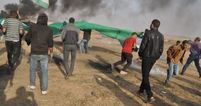
Ninety Palestinians, including 12 children and a woman, have been killed by Israeli fire since US President Donald Trump’s recognition of Jerusalem as capital of Israel in December, medical sources reported.
Palestinian Health Ministry said in a statement issued Sunday that ninety persons were killed by Israeli forces throughout occupied territories since Trump’s recognition of Jerusalem.
Since the start of the Great Retrun March on March 30, 53 Palestinians have been killed and over 9,545 have been wounded by Israeli fire including 900 children, 400 women, 200 medics, and 110 journalists.
The U.N., European Union and rights groups have accused Israel of using excessive force against unarmed protesters.
Palestinian Health Ministry said in a statement issued Sunday that ninety persons were killed by Israeli forces throughout occupied territories since Trump’s recognition of Jerusalem.
Since the start of the Great Retrun March on March 30, 53 Palestinians have been killed and over 9,545 have been wounded by Israeli fire including 900 children, 400 women, 200 medics, and 110 journalists.
The U.N., European Union and rights groups have accused Israel of using excessive force against unarmed protesters.
11 may 2018

The Israeli police said it completed all security preparations for the opening ceremony of the US embassy in Occupied Jerusalem next Monday, May 14.
In a statement on Thursday, the police said thousands of security forces and volunteers would be deployed throughout Jerusalem on Monday morning ahead of the ceremony.
The police added that hundreds of officers will be placed, in particular, in the Arnona neighborhood where the embassy is located.
In addition to the Israeli police presence, the American delegation will arrive in Israel with its own security forces.
In this regard, the High Follow-Up Committee for Arab citizens of Israel in cooperation with national and religious figures in Jerusalem intend to stage massive marches next Monday in the holy city to protest the relocation of the US embassy.
In a statement on Thursday, the police said thousands of security forces and volunteers would be deployed throughout Jerusalem on Monday morning ahead of the ceremony.
The police added that hundreds of officers will be placed, in particular, in the Arnona neighborhood where the embassy is located.
In addition to the Israeli police presence, the American delegation will arrive in Israel with its own security forces.
In this regard, the High Follow-Up Committee for Arab citizens of Israel in cooperation with national and religious figures in Jerusalem intend to stage massive marches next Monday in the holy city to protest the relocation of the US embassy.
7 may 2018

The Israeli occupation authorities on Monday installed road signs reading the "American Embassy” across streets in Occupied Jerusalem, pending the embassy’s inauguration next week.
Eyewitnesses said three traffic signs reading “US Embassy” in English, Hebrew, and Arabic have been set up in Occupied Jerusalem.
The signposts were placed near a building run by the US consulate south of Occupied Jerusalem, which will reportedly serve as the temporary headquarters of the US embassy, slated to be inaugurated on May 14.
The US President Donald Trump pledged to move his country’s embassy from Tel Aviv to Occupied Jerusalem after recognizing it as the capital of Israel, in a move that fueled unabated tensions across the occupied Palestinian territories and the region.
Eyewitnesses said three traffic signs reading “US Embassy” in English, Hebrew, and Arabic have been set up in Occupied Jerusalem.
The signposts were placed near a building run by the US consulate south of Occupied Jerusalem, which will reportedly serve as the temporary headquarters of the US embassy, slated to be inaugurated on May 14.
The US President Donald Trump pledged to move his country’s embassy from Tel Aviv to Occupied Jerusalem after recognizing it as the capital of Israel, in a move that fueled unabated tensions across the occupied Palestinian territories and the region.
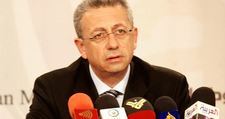
Secretary-General of the Palestinian National Initiative Mustafa al-Barghouti on Sunday called for a popular intifada in all Palestinian territories next week to mark the 70th anniversary of the Palestinian Nakba.
Al-Barghouti in press statements described the US administration's plan to move its embassy to Jerusalem on the anniversary of the 1948 Nakba as a "disgraceful act".
He added that the US administration's recognition of Jerusalem as Israel's capital is a participation in a grave violation of international law and a war crime that involves the annexation of an occupied territory by force.
He stressed that it is no possible for the Palestinians to let the US-Israeli scheme pass without confrontation, calling on the Palestinian Authority to act on the diplomatic level to stop this conspiracy.
Al-Barghouti in press statements described the US administration's plan to move its embassy to Jerusalem on the anniversary of the 1948 Nakba as a "disgraceful act".
He added that the US administration's recognition of Jerusalem as Israel's capital is a participation in a grave violation of international law and a war crime that involves the annexation of an occupied territory by force.
He stressed that it is no possible for the Palestinians to let the US-Israeli scheme pass without confrontation, calling on the Palestinian Authority to act on the diplomatic level to stop this conspiracy.
4 may 2018
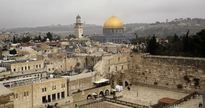
Maariv newspaper on Friday morning reported that US president Donald Trump's new peace plan would include Israel giving the Palestinian Authority (PA) four of Jerusalem's Arab neighborhoods.
The Hebrew newspaper said that the plan was revealed to Israel's War Minister Avigdor Lieberman during his latest visit to Washington and it includes giving Shu'fat, Jabal al-Mukaber, al-Isawiya, and Abu Dis neighborhoods to the PA.
These neighborhoods would form the capital of a future Palestinian state, the paper added.
The US plan, known as the deal of the century, has been revealed so far to senior Israeli officials only. According to Maariv, the US expects Israel to accept the plan and the "painful concessions" it entails.
The plan does not include Jerusalem's Old City which will be recognized as an international territory.
Maariv noted that the US has pledged unconditional support for Israel on the political and military levels in case a war breaks out between Israel and Iran.
A French diplomat told the London-based Asharq al-Awsat newspaper that Trump's plan includes the establishment of a Palestinian state on the ruins of 40% of the West Bank with East Jerusalem (the four neighborhoods) as its capital.
He added that it is likely that giving up the four neighborhoods is the first stage of the implementation of the US plan.
The Hebrew newspaper said that the plan was revealed to Israel's War Minister Avigdor Lieberman during his latest visit to Washington and it includes giving Shu'fat, Jabal al-Mukaber, al-Isawiya, and Abu Dis neighborhoods to the PA.
These neighborhoods would form the capital of a future Palestinian state, the paper added.
The US plan, known as the deal of the century, has been revealed so far to senior Israeli officials only. According to Maariv, the US expects Israel to accept the plan and the "painful concessions" it entails.
The plan does not include Jerusalem's Old City which will be recognized as an international territory.
Maariv noted that the US has pledged unconditional support for Israel on the political and military levels in case a war breaks out between Israel and Iran.
A French diplomat told the London-based Asharq al-Awsat newspaper that Trump's plan includes the establishment of a Palestinian state on the ruins of 40% of the West Bank with East Jerusalem (the four neighborhoods) as its capital.
He added that it is likely that giving up the four neighborhoods is the first stage of the implementation of the US plan.
3 may 2018
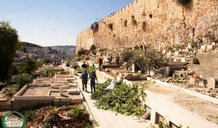
For the fourth consecutive day, Israeli forces continue to attack the centuries-old Bab Al-Rahma Islamic cemetery near Al-Aqsa mosque, by digging up graves of Palestinians.
According to the PNN, WAFA agency reported, on Wednesday, that a number of Palestinians were injured after being physically attacked by Israeli forces, as the latter continued to desecrate an ancient Muslim cemetery, just outside Jerusalem’s Old City wall.
The soldiers continued to dig up graves and land in the cemetery, and to place metal fences in parts of it, while soldiers assaulted a group of Palestinians who managed to access the cemetery and attempted to prevent the continuing violation of the cemetery.
Israeli authorities intend to build a “National Park” on its lands.
Desecration of not only Islamic holy sites, but Christian as well, by Israelis, occurs on a near routine basis, in occupied Palestine.
Archive IMEMC post 07/17/17: Israel Is Not As Christian-Friendly As You Think
According to the PNN, WAFA agency reported, on Wednesday, that a number of Palestinians were injured after being physically attacked by Israeli forces, as the latter continued to desecrate an ancient Muslim cemetery, just outside Jerusalem’s Old City wall.
The soldiers continued to dig up graves and land in the cemetery, and to place metal fences in parts of it, while soldiers assaulted a group of Palestinians who managed to access the cemetery and attempted to prevent the continuing violation of the cemetery.
Israeli authorities intend to build a “National Park” on its lands.
Desecration of not only Islamic holy sites, but Christian as well, by Israelis, occurs on a near routine basis, in occupied Palestine.
Archive IMEMC post 07/17/17: Israel Is Not As Christian-Friendly As You Think
